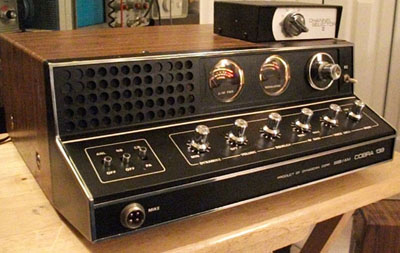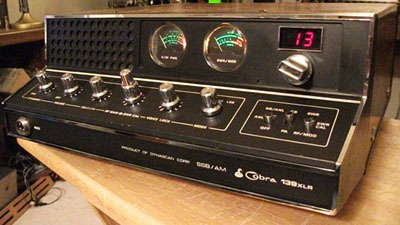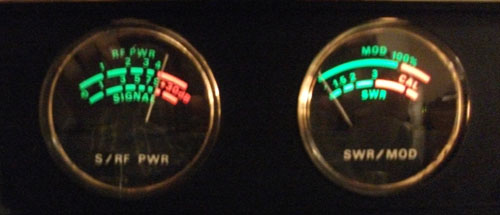 vs.
vs.

The mid 1970's was a major explosive growth period for Citizens Band radio. People started flocking to the channels in droves, as they discovered this primitive social networking system. Although the design of CB radios typically restricted talking distance to less than 30 miles, there were all sorts of people out there to socialize with and, much to the consternation of the FCC, popularity of this hobby element spread. It didn't help that Hollywood started cranking out movies featuring CB themes. That only increased the visibility of the "hobby", and even more people flooded in. By 1975, the 23 channels of the time had become very crowded in major population areas. Demands began being made to the FCC to add additional channels to help relieve the crowded conditions. In typical bureaucratic fashion, it took the FCC almost 2 years to finally settle on a channel expansion plan. It was decided that on January 1st of 1977, the CB band would expand to 40 channels. The additional 17 channels would consist of what were formerly referred to as channels 22"A", 22"B" (Which many 23 channel sets already had with minor modifications), and 15 more consecutive channels above channel 23. Finally, it appeared that the FCC was actually going to do something good for the CB'ers. At first, the masses rejoiced. Spontaneous partying erupted, much liquor was consumed and if you were born between 1976 and '77, and your parents were CB'ers, well............ This really was a dream come true, or was it?
Not long after the initial euphoria died down, rumors started circulating around the channels that the new 40 channel radios were not going to perform as well as the 23 channel sets we all knew and loved. One prominent rumor stated that the FCC, in order to try to get a handle on all the illegal operating practices, and to cut down on soaring TVI complaints, was reducing power output on the new rigs to 2.5 watts, with no extra reserve to be "peaked up". Modulation was also going to be hard limited to no more than 85%. And if that wasn't enough, other rumors stated that the new rigs were being "cost reduced" to the point where they would not receive as well and would get more "bleed over" than current 23 channel models.
Anyone who's been around the CB hobby for any length of time knows that there's always some sort of rumor floating around. Sometimes they're completely bogus, and other times, there was a certain amount of truth in them. In the case of the 40 channel radio rumors, there was a grain of truth in them, but as was often the case, that grain of truth was deeply buried under a pile of bull droppings. It was true that the FCC was becoming concerned about RFI/TVI, and they did revise the technical specifications for type acceptance of CB radios. Most of these revisions revolved around additional filtering on the various jacks and any connection which could radiate a signal. They also tightened up modulation limiting requirements (but the max was still 100%), and harmonic and spurious output was now spec'ed at -60dbc minimum. But the power output spec remained at 4 watts AM, and 12 watts PEP SSB. They also tightened frequency stability requirements which drove most manufacturers to adopt digital PLL circuits. Also gone was the synchronized transmit/receive clarifier on SSB rigs. New rigs would allow frequency movement on receive only like a Delta Tune. So there were changes, but all in all, it didn't look insurmountably bad. But it's easy to see how this could get totally blown out of proportion.
I also suspect that many of the "bad news" rumors against the new rigs were proliferated largely by people who were looking for a good reason to justify NOT buying a new radio, or trying to get top dollar for their old radio they were trying o sell. I mean, how would you feel if you had just spent $350 (or more) for a brand new SSB base radio, only to find out that it would be obsolete in another year? So there was some comfort to be had in believing that your older radio was somehow "better", even if it didn't have all the new channels from the factory (but they could be added).
So now we finally arrive at the reason for our latest rig shootout. I have pitted a 23 channel Cobra 139 SSB/AM base radio against a freshly 1977 minted 40 channel 139XLR, to see which one actually performs better, in the face of the old rumors. First, we'll compare standard features, then we'll put them both on the test bench and take some numbers. Then we'll pit them against each other in a real world test and compare them subjectively based on feedback from other people on transmit quality, and my own interpretations on the receive side. Then we'll talk a little about the common practical modifications that were done to these kind of radios.
First a disclaimer. Both of my test radios have had a fair amount of mileage under them. And as much as I have tried to align them for best performance, there will undoubtedly be some parts which have drifted in value, especially those little pesky 10V electrolytic capacitors. So as much as I have tried to make this a fair test, I can't be 100% sure that either of these rigs are working as well as they did when they came out of the box new. But I hope they're good enough for this comparison.
First we take a look at the Cobra 139:

This radio came out in the 1974-ish timeframe, and was the next model down from the Cobra 135 deluxe base. The rig shared the 135's sloped front panel ergonomics, and had the usual standard features such as Volume, Squelch, RF Gain, Mic Gain, and TX/RX Clarifier. Front panel switches include separate ones for ANL, NB, and PA. There are also 2 fairly good sized meters for S/RF, and Modulation:

All of this is packaged with a faux woodgrain veneer metal cover.
Next we have the 40 channel brother, the 139XLR:

The 40 channel version of the 139 was manufactured in 1977 and is virtually identical in appearance to its 23 channel brethren. User features are identical, with the exception of the addition of SWR functionality added to this radio. Subtle differences include the placement of the switches, which moved from the far left, to the far right side of the sloped front panel. The NB and ANL functions have been combined on one 3 position switch, so the 3rd switch could be freed up for SWR/Cal/Mod meter functions. There is an additional SWR calibrate control, which shares the spot with the R.F. gain as a double gang potentiometer. One other notable difference is that the Voice Lock (Clarifier) only moves the receiver on the XLR, instead of both transmit and receive on the 23 channel radio. Channel display is now handled by an LED readout which replaces the rotary back-lit number dial for the older radio.
As with the 23 channel radio, the XLR features large twin meters for S/RF on one, with modulation along with the addition of SWR on the other. There is a little more color in these meters as well which, IMHO, is a little more aesthetically pleasing.

So now we move on to the head-head comparison between these radios........
Here are the Bench Test numbers:
Receiver Sensitivity- 139: .2uV Min, .7 uV for 6db S+N/N
139XLR: .1uV Min, .5uV for 6db S+N/N
Adjacent Channel Rejection- 139: 65db
+/-10 Khz 139XLR: 65db
Meter Linearity- 139: 3-4 db/S Unit
139XLR: 3-4 db/S Unit
Transmitter Power- 139: AM: 3 watts, SSB: 8 watts
139XLR: AM: 3.5 watts, SSB: 18 watts (max) (Both levels adjustable)
AM Modulation- 139: 100% (Modulation peaks flat top @ 100 %)
139XLR: 100% (Modulation limiter set)
Spurious Emissions- 139: 2nd Harmonic: -52 dbc, all others: <-52dbc
139XLR: 2nd Harmonic: -57 dbc, all others: <-60dbc
As you can see from the numbers, there isn't a whole lot of difference in the raw data between each radio. Power output seemed a bit low on the 139. There may be a weak final or another part out of tolerance, as I seem to recall these radios doing a little more power back in the day. On the other hand, this particular 139 may have been a really old version, made under the old SSB power rules, which were 15 watts input/8 watts out. I also noticed that the S-Meter on the 139 had a good deal of backswing when receiving other signals with strong modulation, almost as bad as an SBE Console II. Adjacent channel rejection was nearly identical at 65db, but the 139 seemed to overload a bit more than the XLR when the input signal was raised high enough to test ACR. I do not have a second signal generator to test front end overload or receiver desense so I can't quantify that. The spurious output on the 139XLR was a few db better than on the 23 channel version, no doubt as a result of the tighter standards imposed by the FCC on 40 channel radios. Modulation limiting on the XLR was also tighter, holding peak modulation to no more than 100%, while at the same time allowing full modulation to be achieved with a stock microphone at a comfortable talking level at 1 foot away. FCC rules also changed the way SSB clarifiers operated too. On the 23 channel radio, the clarifier moves both the receiver and transmitter synchronously, which allows each different station to net together with each other. But for whatever reason, the FCC nixed having the clarifier move on transmit on the 40 channel radios. I guess they figured the accuracy and stability of the PLL synthesizer would make the need for a movable transmit clarifier superfluous. But there's still enough of a difference in frequency that it makes it tough to have a large group of people on SSB, without the need to touch up the receive clarifier each time a different person transmits.
A comparison of the two radios from a circuitry perspective shows that the newer XLR takes advantage of more integrated circuits, such as the audio amp, the microphone pre-amp, and noise blanker, as well as the PLL synthesizer. Both chassis were made by Uniden, so there were some circuitry similarities. But overall, the basic receiver and transmitter design did not change all that much, and certainly the newer radio was not "cost reduced" or built in such a way as to diminish performance as one rumor implied.
On-Air Subjective Performance Tests:
During a recent local Classic Radio Roundup, I put both 139's on the table and switched back and forth between them to see which radio, if either, performed better. If the old rumors were to be believed, the 23 channel radio should have won hands down. But reality has a way of disproving rumors as the 40 channel radio proved to be every bit as good (and in many ways better) as its older brother.
AM TX Audio Quality:
Both radios were setup to use the same D-104 microphone. The local fellow Classic Radio participants didn't notice much difference in audio quality between the two radios, although they felt that the XLR had a little more presence. I also noticed that the XLR needed less microphone gain to achieve the same level of modulation.
AM Receiver Performance:
During the comparison, I also tried to gauge differences in receiver performance. The XLR seemed to hear a little better, but it was hard to really quantify that though. And since there are no longer dozens of people cramming the channels within a mile of my location, like back in the 70's, I didn't have any means of determining which was the better candidate in rejecting strong signal bleedover. As mentioned before, the 139's "S" meter seemed to backswing on modulation, while the XLR's meter seemed to reflect the actual modulation swing of the received station either forward or backward depending on what they were transmitting. I also attempted to compare the effectiveness of the noise limiter and blanker circuits between the two rigs. Noise blankers are typically meant to suppress pulse type noise, such as what automobile spark plugs would emit. So absent a suitable source of pulse noise, I couldn't determine which radio's blankers did a better job. I do have a curious localized noise, which sounds very much like a car's spark plugs idling. But none of my radios' noise blankers could take it out. To make the mystery even more mysterious, not all of my radios actually hear the noise. I'm thinking it might be dependent on what frequency I.F. the radio has. And if that's the case, it might explain why the noise blankers fail to remove it. In any case, the ANL did remove the noise, or at least, shaved the noise peaks off so that they weren't as noticeable. In this case, both 139's worked equally well. The 139 had separate switches for ANL and NB, so it is possible to turn on the NB independently from the ANL. Such is not the case with the XLR, which has both functions on a single 3-way switch, and you cannot activate the NB without the ANL also being on. So I really couldn't say for sure if the XLR's blanker was affecting the noise above and beyond what the ANL was already handling.
SSB Performance:
On SSB, the audio quality was almost identical between the two radios, but the extra power of the XLR gave it a bit more signal to the others on the channel. The XLR also seemed to receive better on SSB, or at least the meter indicated stronger signals. Receive audio was also very close between the radios. One thing I did notice was that as the radio warmed up, the XLR's frequency would slowly drift down almost 400 hz. from cold. This condition has to do with a lack of cooling vents in the cover. With the cover off, there's no drift problem. And the Realistic TRC-458, which uses the same chassis but has a cover with cooling slots all throughout the top, allows for far less heat buildup, and much less frequency drift. The crystal controlled 139 did not have an appreciable frequency drift issue.
Modifications and Capabilities:
While not a part of the performance test, which compared the radios in their stock unmodified forms, it's interesting to note the things which were normally done to these radios by guys looking to maximize their performance. The 23 channel 139 could be peaked up and modulation level adjusted, similar to other radios. The clarifier range could be easily extended to -12Khz, which gained access to all of the RC channels, channel 22 "B" (25) and 26.955 Mhz. A net gain of 7 channels which was not bad for a about 5 minutes worth of work, and no additional parts. Increasing channel capability on a straight crystal synthesized radio was pretty much limited to a choice between adding an external VFO, or by adding additional crystals for each 5 channels worth of jump you wanted. My 139 had been modified by a previous owner with an external crystal box holding 11 additional crystals. At today's crystal prices, that's not the most economical way of expanding frequency coverage, but it does work.
The 139 XLR, on the other hand, was equipped with a wide open, and easy to modify PLL circuit, utilizing a upd858 chip. With the addition of a few switches and some broadbanding, this radio could cover over 200 channels, without having to add any crystals. Modulation and power could be peaked up just as it could with the older rigs. And that fixed receive-only clarifier could be "corrected" with a cut and jump or two. So the rumor that the 40 channel rigs would not be modification friendly was also laid to rest. In fact, the early 40 channel rigs were enticingly modification friendly, especially in the area of channel expansion. Although by 1980, the FCC started requiring that manufacturers stop offering PLL radios which could be easily modified for out of band channels. So that loophole would eventually close.
Conclusion?
Well, the original point of this comparison was to either validate or disprove the rumors which claimed that 40 channel radios would not perform as well as the 23 channel models they replaced. From what I could tell from this test, the 40 channel model performed at least as well and, in some cases, a little better than the older 23 channel model. In addition, when you consider the modification capabilities of the 40 channel radio, it represents a good value which was usually well worth the upgrade. Of course that was of little comfort for the guy who had just spent a boatload of cash on the 23 channel radio before the bottom fell out. And those guys took some comfort in the rumors, even if they were wrong. All I can say there is that sometimes you find yourself in the wrong place at the wrong time.... Such is life.